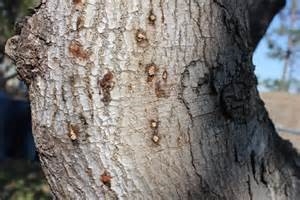- Author: Ben Faber
And doing it in the dark?
In a recent paper, David Pattemore and associates reveal some fairly different observations about avocado flowering. One, that the female stage can be open and potentially receptive to pollination at night. And Two, that moths and crane flies amongst other nocturnal insects are visiting the flowers and carrying pollen!!! These are two very new observations, made possible by the digital world we live in.
Of course, insect visitation doesn't mean fruit set. Is there pollination, transfer of pollen to the female stage? Is there enough pollen? Is it the right pollen? Is it the right temperature for fertilization to occur? Whatever else needs to happen for fruit set, is it happening?
But these observations are opening up new discussion topics for the avocado world.
LOW OVERNIGHT TEMPERATURES ASSOCIATED WITH A DELAY IN ‘HASS' AVOCADO (PERSEA AMERICANA) FEMALE FLOWER OPENING, LEADING TO NOCTURNAL FLOWERING
David Pattemore1,2*, Max N. Buxton1, Brian T. Cutting1, Heather McBrydie1, Mark Goodwin1, Arnon Dag3
1The New Zealand Institute for Plant & Food Research Limited, Ruakura Research Centre, Hamilton 3210, New Zealand
2School of Biological Sciences, University of Auckland, Auckland, New Zealand
3Gilat Research Center, Agricultural Research Organization, 85280, Israel
Abstract—Avocado (Persea americana) has synchronously protogynous flowers: flowers open first in female phase before closing and opening the next day in male phase. Cultivars are grouped based on whether the flowers typically first open in female phase in the morning (type A), or in the afternoon (type B). However, it is known that environmental factors can alter the timing of flower opening, with cold temperatures being shown to affect the timing of flowering. The aim of this study was to investigate how low spring temperatures in New Zealand affect the flowering cycle of commercial avocado cultivars, focusing primarily on the receptive female phase of ‘Hass', a type A cultivar. Time-lapse photography was used to assess flower opening times of ‘Hass' over three years. Decreasing minimum overnight temperatures were associated with a delay in the timing of ‘Hass' female flower phases and resulted in nocturnal flowering of both male and female phase flowers. We recorded insects visiting female flowers at night, and some nocturnal flower visitors collected were carrying avocado pollen. Our study suggests that nocturnal pollination needs to be considered for avocados grown in temperate regions. Furthermore, as the timing of the female phase of ‘Hass' varied significantly with overnight temperature, the activity patterns of potential pollinators need to be considered to ensure adequate pollinator activity across the range of times in which ‘Hass' flowers are receptive.
Eight different invertebrate orders were captured from avocado flowers at night. Coleoptera, Diptera and Lepidoptera were the most frequently caught floral visitors, but it was coleopteran, dipteran and neuropteran individuals that carried the greatest number of pollen grains on average. This is an important distinction to make, as not all floral visitors behave as pollinators: visitation does not necessarily infer pollination. Species such as Costelytra zealandica (Coleoptera), Micromus tasmaniae (Neuroptera), along with Tipulidae and Sylvicola species (Diptera) may be especially important, as these were both frequently caught and often carried a high number of pollen grains. Compared with diurnal pollination, nocturnal pollination is poorly understood and relatively little research in New Zealand has tested assumptions that nocturnal floral visitors can act as pollinators.
This is an interesting read and introduces further areas of pursuit to understanding what brings on fruiting in the wild avocado.
Read On:
click on Download this PDF file
Rhapsa scotosialis – a potential avocado pollinator?
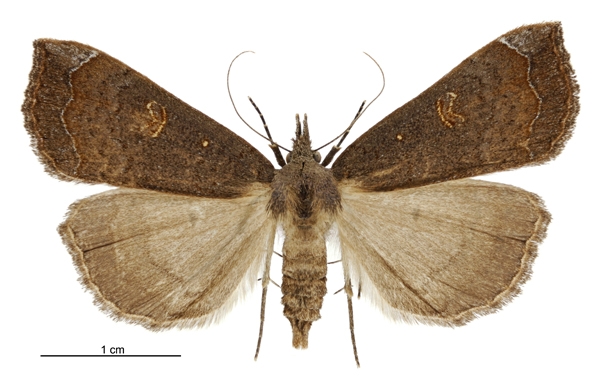
- Author: Ben Faber
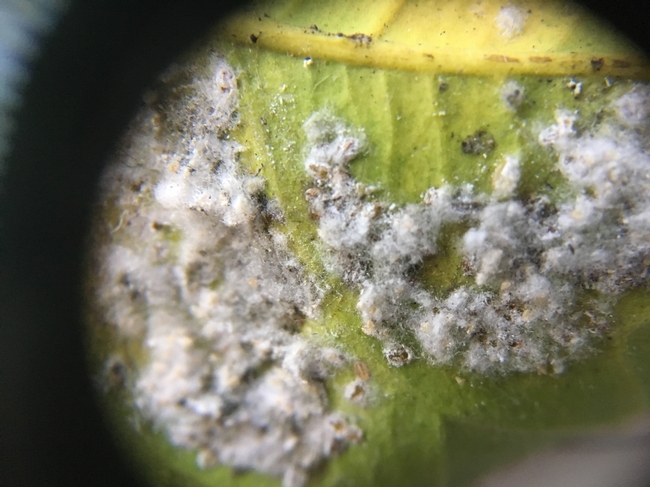
Wow, woolly whitefly covered with waxy, curly filaments , Aleurothrixus floccosus.
One of the consequences of fire and the resulting ash is that the biocontrol agents that keep whiteflies, scale, mealybug and other pests in balance is that they will spend so much of their time preening that they don't have time to go after their prey. Lacewing larvae, minute pirate bug, ladybird larvae, parasitic wasps and others rely on moving around to get at their food sources. When they cant move fast, they stop and clean their joints to stay limber. Whitefly and scale insects just hunker down and don't need to do a lot of moving. They just breed, and without actively moving biocontrol agents, their populations can explode. Or that's my human analogy. In dusty areas or areas affected by ash, the particles get in their joints and they need to spend time cleaning in order to move fast.
Whiteflies suck phloem sap, which in some cases can cause leaves to wilt and drop when there are high numbers of whiteflies. However, the primary concern with whiteflies is the honeydew they produce. Honeydew excreted by nymphs and adults collects dust and supports the growth of sooty mold; large infestations blacken entire trees, including fruit, as well as attract ants, which interfere with the biological control of whiteflies and other pests. The sooty mold can also affect tree yields by reducing photosynthesis and requiring extra handling time for cleaning.
So pests under good control prior to a fire can get out of hand. This is a good example of a tree in the town of Ventura where ash was a problem. A seemingly clean tree, free of whitefly, started to defoliate with blotchy leaf spots. On the undersides of the leaves corresponding to the blotches are colonies of whitefly. And looking closely you can see that some of the nymphs have exit holes, indicating that they have been parasitized by a wasp. So nature is kicking in and taking it's course. The whitefly should get cleaned up soon too by some forager, such as lacewing larvae or pirate bug. No need to spray because it would just be a further disruption.
See more about whiteflies at:
http://ipm.ucanr.edu/PMG/PESTNOTES/pn7401.html
Photos: Defoliating 'Meyer' lemon tree, blotches on upper side of leaf, whitefly colonies with exit holes in some of the nymphs
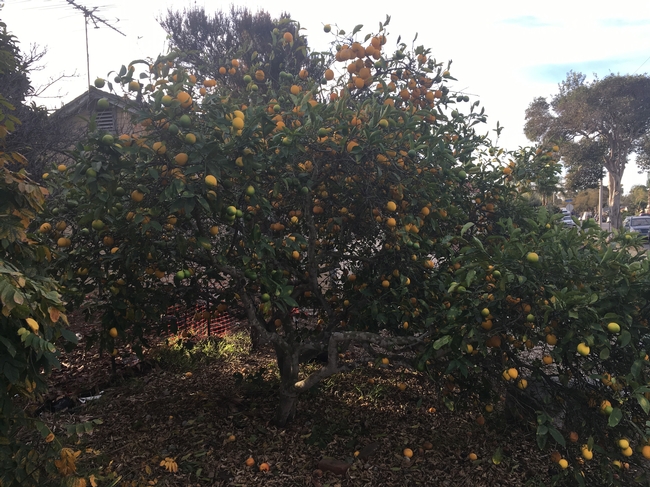
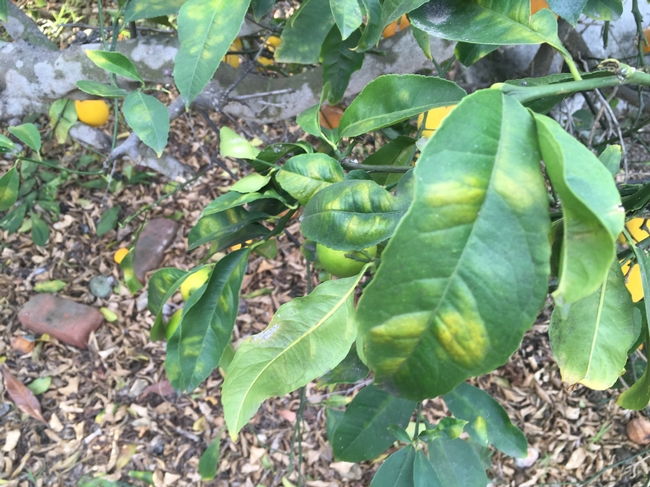
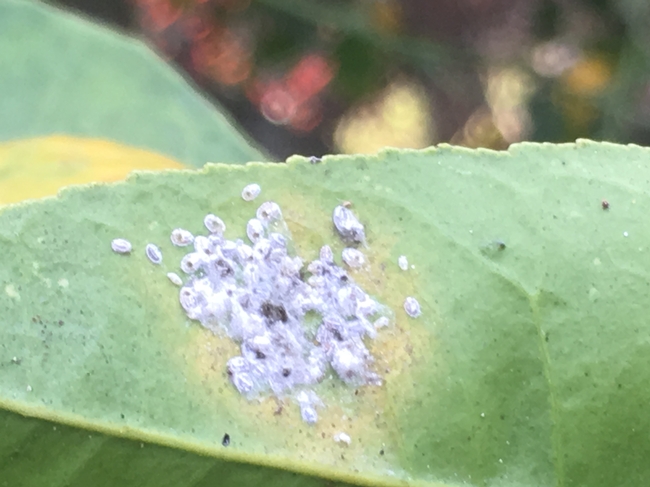
- Author: Ben Faber
You always wanted to know what pollinated rambutan, litchi, blueberries and all those other plants dependent on insect pollen movement? O yes, and also what is pollinating avocado?
Insect Pollination Of Cultivated Crop Plants
by S.E. McGregor, USDA
Originally published 1976
The First and Only Virtual Beekeeping Book Updated Continuously.
Additions listed by crop and date.
This book is out-of-print, but can be found on-line at ABE Books and then you can get the images that are missing from the online version of the book
https://www.ars.usda.gov/ARSUserFiles/20220500/OnlinePollinationHandbook.pdf
This is an old book with a lot of old information, but a lot of it is still good. There is definitely more up-to-date information, but this is a good starting point. For avocado, another good source, or course is AvocadoSource which also has quite a number of articles on pollination of other tree species
http://www.avocadosource.com/search.asp
Recently a group of UC Riverside researchers met to align themselves around the topic of pollination - The biology, effects, interactions of the various pollinator and pollinizers and how they are affected by our environment and how we might be able to manage them better. The participants in this pollination group have all manner of expertise and hopefully their interaction will bring a synergy of understanding to this very complicated subject.
Photos: Syrphid (hover) fly, bumblebee, honeybee, thrips carrying pollen
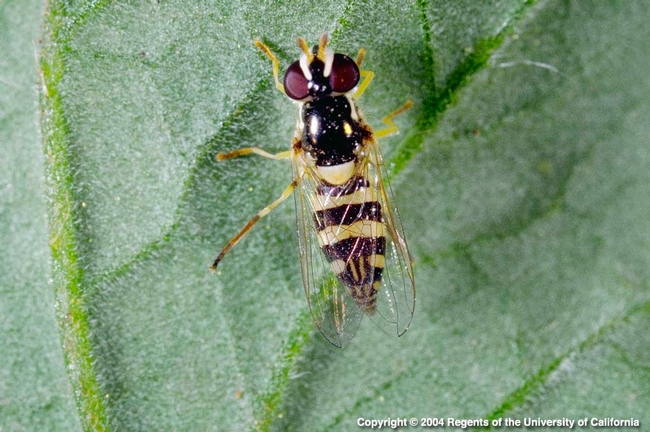
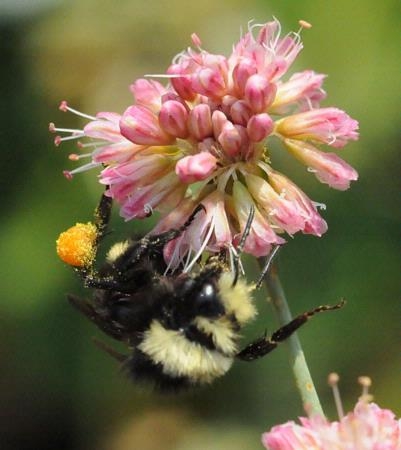
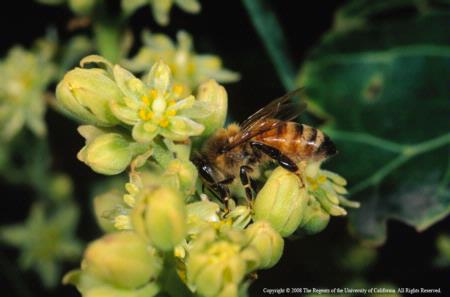
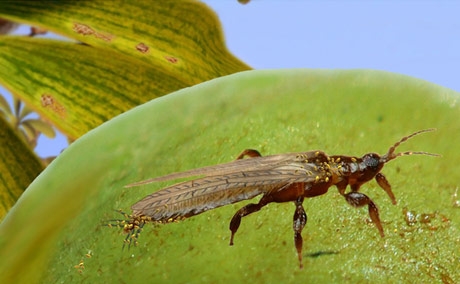
- Author: Ben Faber
It's that time of year for a riot of aphids on new growth cheeseweed (malva) and wild radish and with that food source to see ladybird beetles go to town, chowing down. There's ladybugs in both their larval and adult stages doing the feeding. Some of the larvae look like mealybugs which is a food source that they mimic and also feed on. The mealybug destroyers was introduced from Australia at the turn of the 20th century to fight citrus mealybug and when there is no disruption, they are effective at keeping the population down. Another mealybug mimic is the dusky ladybird which also feeds on scales, aphids and mealy bugs. These are generalist predators, even cannibalizing their own, when other food sources are not present. The dusky has not been common in the Ventura area, but recently, PCA Jane Delahoyde spotted one. As our weather changes, we are bound to see other insects and invertebrates move into the area.
Check out this University of Florida ladybug website:
http://entnemdept.ufl.edu/creatures/beneficial/lady_beetles.htm
Mealybug-like larval stage surrounded by aphid food (above) and adult (below)
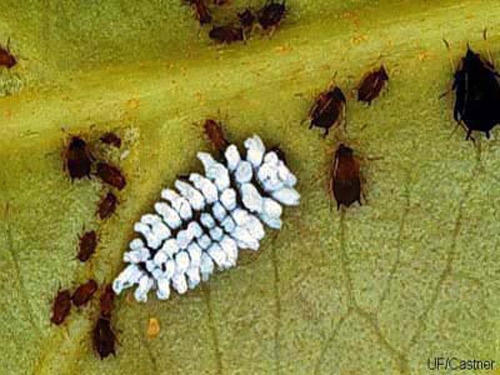
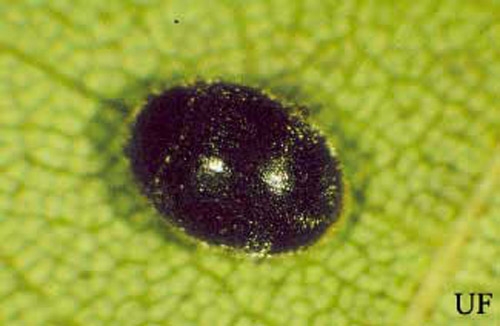
- Author: Jim Downer
As we continue an historic drought in California, trees all over Southern California are showing symptoms of stress, and in some cases have died due to drought and pests that attack drought stressed trees. Despite recent and significant rainstorms, it is likely that trees will again be stressed later in the irrigation season. Trees and other woody plants in nurseries also bear the burden of drought stress as irrigation waters become increasingly salty because of drought effects on wells and reliance on stored water in reservoirs continues.
The Polyphagous shot hole borer is a serious pest of nursery and landscape trees and threatens many species. As such, counties adjacent to Los Angeles are at risk of invasion by this new exotic pest and we are watching and monitoring trees for possible extant new detections. The drought has stressed many of the signature trees that could be attacked by PSHB and these trees are often attacked by native or established pests. In some cases these beetles closely resemble PSHB and cause symtpoms of bleeding and in some cases cambial discoloration and gallery formation similar to that of PSHB.
On coast live oak (Quercus agrifolia) there are two look alike beetles the western oak bark beetle (Pseudopityophthorus pubipenis) and the Oak ambrosia beetle (Monarthrum scutellare). The western oak bark beetle is common in Southern California and the ambrosia beetle more common in the northern half of the state but both have been detected throughout California. As with many beetle/tree interactions both of these are attracted to drought stressed trees. When attacked coast live oak bleeds heavily and these insects often attack in larger numbers uniformly along the main stems or trunk. Examination of the cambium of Oak Bark Beetle attacked trees reveals small galleries and little or no necrotic tissue.
Prunus spp such as peach, nectarine, plum and apricot are common in back yards and retail nurseries. This year we are seeing much increased attack of these trees by the European fruit borer or shot hole borer (Scolytus rugulosus) a beetle very similar in stature to PSHB. The insect is the same size as PSHB and makes numerous holes and causes excessive bleeding in Prunus. This insect also seems to carry a fungal pathogen resulting in cambial necrosis.
One other insect that could be mistaken for PSHB is the walnut twig borer which vectors Thousand Cankers Disease of walnuts (both native and English). This beetle (Pityophthorus juglandis) carries with it a fungus Geosmithia morbida, that causes extensive cambial necrosis, and ultimately twig and branch dieback results from its presence.
